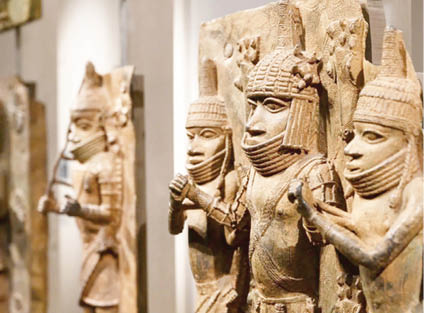The return of Benin bronze artifacts
The media space is suddenly inundated with news of the return of the bronze artifacts that were infamously looted from the palaces and shrines of the Benin Kingdom in 1897. The news of the return of the looted artifacts was lavishly reported in the media last week, and they would be coming back from Germany […]

Some Benin bronzes
The media space is suddenly inundated with news of the return of the bronze artifacts that were infamously looted from the palaces and shrines of the Benin Kingdom in 1897. The news of the return of the looted artifacts was lavishly reported in the media last week, and they would be coming back from Germany and Britain. The news items would gladden the hearts of many who for years have followed the sojourn of these artifacts in foreign lands. These artifacts that have over the years become highly valued, almost priceless, are strewn around in museums, universities, and private homes in the UK, France, Germany, the USA, Canada, and many other European nations.
In many of these places, these looted Benin artifacts are brazenly displayed, without any feeling of remorse. During the preparations for FESTAC in the mid- 1970s when Nigeria chose one of the iconic images of Benin art, the Mask, to serve as a mascot, then with the British Museum, the British were reluctant to release it to us. It was only after protracted negotiations that it was released. And to add salt to injury, the Mask was only released to us on loan with stiff conditions of insurance.
It is instructive to recall that in the 19th Century many European countries engaged in all forms of banditry and wanton looting along the coast of West Africa all in the name of trading and civilising efforts. The English were predominant in the Niger Delta, trying to garner favourable trading pacts with the major kingdoms in the area running from Calabar to Lokoja. But they found the Benin Kingdom a hard nut to crack due to perhaps its formidable power and influence.
However, an incident occurred in 1896 whereby an English Counsel and his entourage tried to override some Benin cultural sensibilities to have an audience with the Oba. Unfortunately, they met with their comeuppance and many were killed, as the Bini never tolerated disrespect to ancient traditions. Following the incident and the furor it caused in the UK, the British raised a punitive expedition in February 1897 and sent it to Benin. They came down heavily on Benin, gunboats and all, in an orgy of massacres. After subjugating the people, the British captured Oba Ovanramwen Nogbaisi and sent him off to Calabar in exile. They also hanged most of the captured high chiefs.
- Lawmakers seek better welfare for journalists
- Potential flashpoints to watch ahead of 2023 elections
The British then went into a systematic plundering of the palaces and the innumerable shrines that dotted the city, taking away some 2500 (official figures) religious artifacts visual history, mnemonics, and artworks. The British considered the valuable artifacts as war booty and kept some in their museums and auctioned a lot to French, German, and other art lovers all over Europe. On the positive side, the dispersal of the artifacts in Europe brought about a reassessment of West African art. Over the years now the Benin artifacts have achieved a status of excellence. They have been widely copied and the style integrated into universal art forms.
The Benin Kingdom never forgot its artifacts and persistently kept calling for their return. This culminated in the formation of a multi-lateral international collaborative working group called the Benin Dialogue Group in 2007 that brought together all the stakeholders comprising delegates from Western museums with representatives of the Nigerian government, the Royal Court of Benin, and the Nigerian National Commission for Museums and Monuments. The group’s focus was the re-possession of the Benin artifacts and the creation of a permanent display point in Benin City.
While all this was going on, a Professor of museology and anthropology, Abba Isa Tijjani, was appointed the Director-General of the Nigerian National Commission for Museums and Monuments (NCMM) in 2020. He is a renowned scholar of the subject matter who is reputed to have worked at the school of Oriental and African Studies of the University of London. Having been out there in Europe he knew where these looted artifacts were and how to go about getting them back home. The results that are showing now, are that of his sustained efforts in the last two years running around the European capitals, mostly appealing to their conscience, to return these artifacts to their rightful owners.
The artifacts are due to start coming in this year. The NCMM has promised to build a special Benin Royal Museum with the support of international stakeholders to house and showcase these artifacts. I hope this will be done quickly to underline our seriousness to receive them. While we are at this it may be pertinent to observe that the National Museum is still tucked away in Lagos. There is no building designated as the National Museum in Abuja leaving the Federal Capital bereft of a place to showcase our rich past.
The other sore point is the lack of a National Theatre in Abuja. The one that was built in Lagos, when it was the federal capital, for FESTAC in 1977, was exciting for the time. I was in the NYSC that year and I still recall the feeling of accomplishment whenever I attended shows there. Sadly, the National Theatre has been left to rot until the Central Bank of Nigeria stepped in, recently, to rehabilitate it. I understand that even when the rehabilitation exercise is completed it will be handed over to Lagos State.
